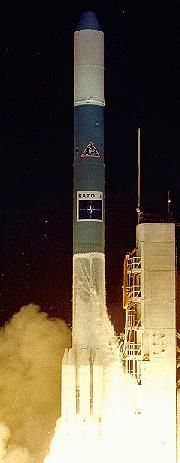Delta 2000 (original) (raw)

Home - Search - Browse - Alphabetic Index: 0- 1- 2- 3- 4- 5- 6- 7- 8- 9
A- B- C- D- E- F- G- H- I- J- K- L- M- N- O- P- Q- R- S- T- U- V- W- X- Y- Z
Delta 2000

Delta 2914 no. 146
Delta 2914 no. 146 - COSPAR 1978-106
American orbital launch vehicle. The Delta 2000 series used Castor 2 strap-ons together with an Extended Long Tank core equipped with the more powerful RS-27 engine. This engine was derived from surplus H-1 engines intended for the Saturn IB booster of the Apollo program. The Delta P upper stage was built by Douglas and used surplus Apollo lunar module engines from TRW.
Status: Out of production. Payload: 724 kg (1,596 lb). Thrust: 2,287.50 kN (514,250 lbf). Gross mass: 130,392 kg (287,465 lb). Height: 35.00 m (114.00 ft). Diameter: 2.44 m (8.00 ft).
Payload: 724 kg (1,596 lb) to a GTO. Flyaway Unit Cost 1985$: 28.520 million.
Stage Data - Delta 2000
- Stage 0. 9 x Castor 2. Gross Mass: 4,424 kg (9,753 lb). Empty Mass: 695 kg (1,532 lb). Thrust (vac): 258.915 kN (58,206 lbf). Isp: 262 sec. Burn time: 37 sec. Isp(sl): 232 sec. Diameter: 0.79 m (2.59 ft). Span: 0.79 m (2.59 ft). Length: 6.04 m (19.81 ft). Propellants: Solid. No Engines: 1. Engine: TX-354-3. Status: In Production.
- Stage 1. 1 x Delta Thor RS27. Gross Mass: 84,368 kg (185,999 lb). Empty Mass: 4,360 kg (9,610 lb). Thrust (vac): 1,030.218 kN (231,602 lbf). Isp: 296 sec. Burn time: 223 sec. Isp(sl): 262 sec. Diameter: 2.44 m (8.00 ft). Span: 2.44 m (8.00 ft). Length: 22.37 m (73.39 ft). Propellants: Lox/Kerosene. No Engines: 1. Engine: RS-27. Other designations: Extended Length Thor RS-27. Status: Out of Production.
- Stage 2. 1 x Delta P. Gross Mass: 5,434 kg (11,979 lb). Empty Mass: 820 kg (1,800 lb). Thrust (vac): 41.923 kN (9,425 lbf). Isp: 301 sec. Burn time: 322 sec. Diameter: 1.38 m (4.52 ft). Span: 1.38 m (4.52 ft). Length: 5.97 m (19.58 ft). Propellants: N2O4/Aerozine-50. No Engines: 1. Engine: TR-201. Other designations: TR-201. Status: Out of Production.
- Stage 3. 1 x Burner 2. Gross Mass: 774 kg (1,706 lb). Empty Mass: 116 kg (255 lb). Thrust (vac): 43.551 kN (9,791 lbf). Isp: 285 sec. Burn time: 42 sec. Isp(sl): 220 sec. Diameter: 0.66 m (2.16 ft). Span: 0.66 m (2.16 ft). Length: 0.84 m (2.75 ft). Propellants: Solid. No Engines: 1. Engine: Star 37. Status: Out of Production. Burner II was a launch vehicle upper stage developed by Boeing for the Air Force Space Systems Division. It was the first solid-fuel upper stage with full control and guidance capability developed for general space applications. Burner II was designed for use with the Thor booster, but was readily adapted for use on the complete range of standard launch vehicles. Its general assignment was to place small- and medium size payloads into orbit. The Burner II motor, guidance system and reaction control system were integrated to provide attitude stability and precise control of flight rate and burnout velocity for orbital injection and earth-escape missions. Boeing had delivered 8 flight vehicles under its original contract. Under terms of a follow-on contract, it built 6 additional flight models. Four Thor-Burner II combinations were launched successfully from Vandenberg Air Force Base, California. The third launch placed 2 unclassified satellites in Earth orbit. A SECOR satellite, built for the U.S. Army Corps of Engineers by the Cubic Corporation, and an Aurora satellite, developed by Rice University for the Office of Naval Research, were placed in circular orbits 3,300 km above the Earth. As integration contractor for the Air Force Space Experiment Support Program (SESP) Office, Boeing designed, built and tested the injection stage, or "payload dispenser," which carried the 2 satellites on top of a standard Burner II stage and placed them in precise orbits. The satellites were mounted on opposite sides of the injection stage, which housed a640 kgf thrust, solid-propellant rocket motor. The Burner II was used as an upper stage by NASA for deep space probes. Prime Contractor: The Boeing Company. Major Subcontractors Thiokol Chemical Corporation (solid rocket motor); Honeywell Inc. (pre-programmed inertial guidance system); Walter Kidde Co. (reaction control system).
Family: orbital launch vehicle. Country: USA. Engines: RS-27, TR-201. Spacecraft: Oscar, AE, Nimbus, ITOS, Landsat 1-2-3, HS 333, Skynet, SMS, Intasat, Symphonie, COS, Spacebus 100, GOES, CTS, Marisat, NATO 3, LAGEOS, ESA-Geos, Himawari, Sirio, ISEE, Meteosat, CS-1, IUE, PIX, Yuri, CAMEO, SCATHA, SME, SSTL-70. Stages: Star 37. Agency: Douglas.
Home - Search - Browse - Alphabetic Index: 0- 1- 2- 3- 4- 5- 6- 7- 8- 9
A- B- C- D- E- F- G- H- I- J- K- L- M- N- O- P- Q- R- S- T- U- V- W- X- Y- Z
© 1997-2019 Mark Wade - Contact
© / Conditions for Use